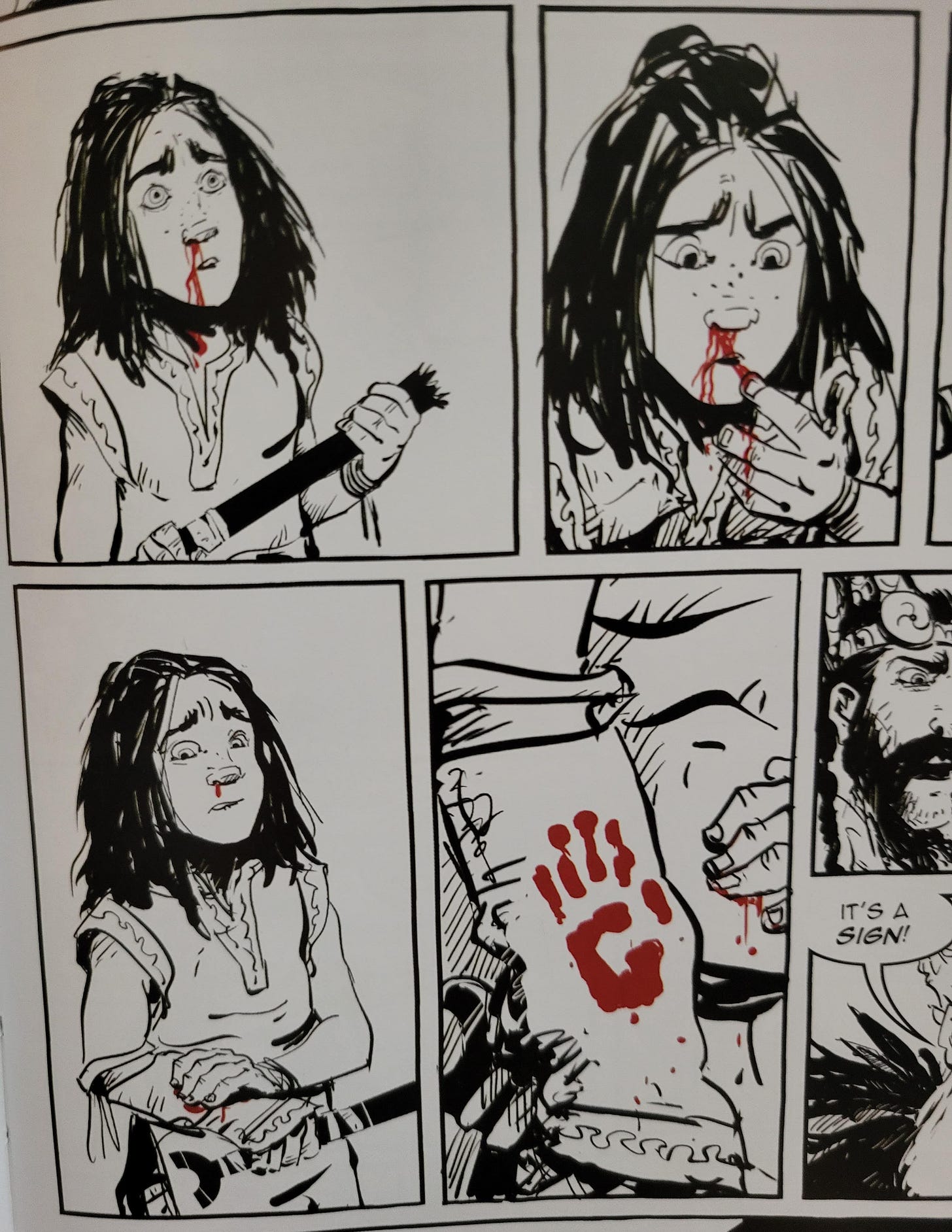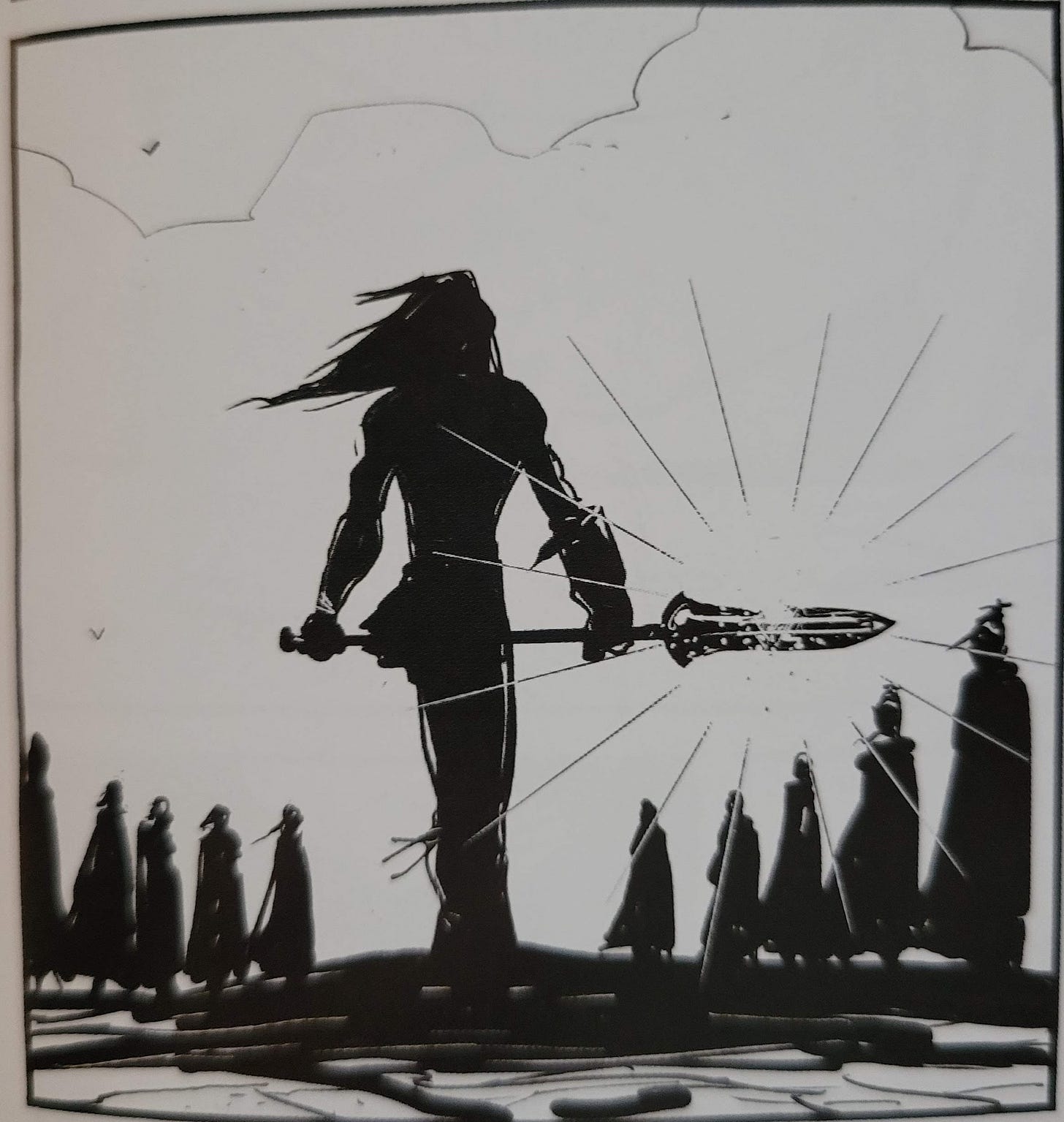"Hound" - First Impressions
Collection of my initial notes on Paul J. Bolger's epic graphic novel
This is far from the formalized review I have planned for the Hound graphic novel, but I wanted to give my readers a preview of my initial thoughts after finishing it two weeks ago.
Hound captured my interest when I came across its Kickstarter page back when I was in college (either in 2019 or 2020). I had not taken a formal class in Irish mythology or Celtic studies, yet I had read versions of the stories of Cú Chulainn in Marie Heaney’s collection Over Nine Waves: A Book of Irish Legends (1994) and later in Thomas Kinsella’s version of The Táin (1969).1 What struck me about Hound was its focus on Cú Chulainn’s relationship with the Irish goddess Morrígan, as even before I pursued Celtic studies for my academic career I recognized that she only had a minor role in Cú Chulainn’s stories. At the time, I was still mostly unaware of the scholarly discourse around Irish mythological texts so I did not have the same critical eye I acquired during my master’s program.
Hound quietly fell off my radar until 2022 when it was released in a single volume by Darkhorse Comics. By then, I was nearing the end of my first year of my master’s program and my mindset towards Celtic-inspired media changed to be somewhat more critical, yet open to new interpretations and adaptations of the stories within the corpus of Celtic studies. I had also certainly gained new information about the ancient Celts, their religion, and perspectives on their myths seldom discussed among general audiences.
I am not a lifelong graphic novel or comic book reader (although I have been making my way through Berserk with plans to read other manga), but once I started gearing up to launch Senchas Claideb I knew I had to review Hound. Bolger clearly poured a lot of work and passion into every panel and line when creating this adaptation and the artwork is a refreshing take on Irish mythological characters and scenes. Norse language and myth specialist Jackson Crawford made a video arguing that we need more artistic renditions of the Norse gods from present-day to replace the overused and often inaccurate oil paintings that are copy-pasted into textbooks. Bolger has done something similar here where instead of drawing on depictions from the Celtic Twilight Movement2 his style for Hound instead is reminiscent of the harsh, sometimes “primitive” illustrations in Kinsella’s The Táin (illustrated by Louis le Brocquy). Black and red are the only colors used throughout the entire story, but each panel is nonetheless dripping with character and mystique to portray a past that we might never know the entire scope of.
Scenes like the above picture especially reminded me of the sketchy, impressionistic drawings from Kinsella’s edition. Bolger uses more exact detail and over fantasy inspiration than le Brocquy but I can’t help but imagine his drawings were influential in crafting Hound.
Credit: Bolger (2022)
While reading, I had to constantly remind myself that the story was merely an adaptation and liberties were taken to make it digestible for a more general audience than a scholarly one. In general, I felt the story was more of a dark fantasy dramatization of the source material than a 100% faithful graphic novel adaptation. It is my plan to make two complete reviews of Hound: one will review the graphic novel on its own merits, and the second will be an analysis from the point of view of someone who has extensively studied Celtic myth and literature (namely the stories of Cú Chulainn’s life and death).
For a volume as dense as Hound is (clocking in below 500 pages), I read through it quicker than I anticipated, which I suppose is part of the nature of graphic novels (though I say this having read 8 deluxe volumes of Berserk in around 3 months). As I said before, I’m not a regular or lifelong graphic novel reader, which may be partly why I was confused at the parts where action or story beats seemed rather truncated or skipped entirely—I’m not sure if it’s a regular motif in graphic novels and comics to leave out transitional scenes or certain instances of context. Despite those few instances, the story is rather straightforward and is often less complex and sprawling as its source material. The story is centered solely on Cú Chulainn (or Cu Cullan as his name is spelt in Hound) and his struggle against his violent nature seeded by Morrígan. Despite the liberties or inconsistencies, there were actually instances that I felt worked better in terms of explaining parts of the story which leave many readers (including scholars) of the original text confused. Overall, I’ve enjoyed my time with Hound as one of the latest additions to Celtic-inspired media. I’ll save my more in-depth opinions for my full review but at the very least, fans of the sagas of Cú Chulainn and dark action-adventure comics may enjoy it.
You can purchase Hound directly from Dark Horse Comics’ website here.
Do you have a friend who likes comics, mythology, dark fantasy, or all of the above? Refer them to Senchas Claideb using the link below. You’ll receive access to special rewards, including a free, original dark fantasy short story if you refer 25 friends!
I recommend both of these texts for audiences who are interested in delving into Irish mythology without necessarily engaging in scholarly discourse. More complete versions of the Táin Bó Cúailnge (“Cattle Raid of Cooley”) translated by Cecille O’Rahilly are available to read online here.
Also called the Celtic Revival, this late 19th to early 20th century movement was largely based in Ireland and had contributing members in the other Celtic-speaking nations (Scotland, the Isle of Man, Cornwall, Wales, and Brittany). W.B. Yeats is one of the foremost members of this movement and his works are in part responsible for popular conceptions of Celtic folklore.






It's a shame how much fiction based on mythology 'it's good on it's own but not great as an adaptation' applies to, scholarly research seems to lower enjoyment of this kind of media sadly. Interested to hear more on the faithfulness review.